Choosing an Electrical Switch
More
Limit Switches
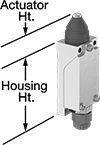
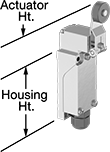
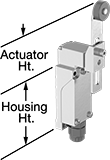
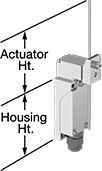
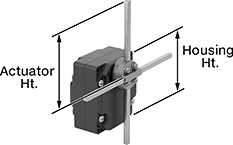

When a moving object contacts the actuator on these switches, they open or close a circuit. They have the rapid-closing action of a snap-acting switch, but with a larger actuator. This makes them a good choice for use with large objects—for instance, a box on a conveyor runs into the switch, stopping the conveyor.
Switches with a plunger actuator require a push to actuate, similar to a button.
Switches with a roller lever actuator use a lever with a roller at the end to activate. This allows parts to glide across the actuation surface with minimal friction, limiting wear and tear on your switch.
Switches with a rod actuator use a rod extending out of the body to actuate, so they’ll activate even if an object is far away.
Switches with a T-rod actuator have four rods extending in different directions from a pivot point. If an object contacts any of the rods from any direction, these switches actuate. Since they have such a large actuation area, they’re great for detecting moving parts when your machine tool isn’t perfectly aligned.
Switches with a wobble stick actuator have an arm that rotates 360°, so you don’t need to align it in a specific direction. Since the actuator is flexible, it won’t snap if pushed backward. That makes these switches a great choice for systems that get jammed often.
Styles E and F let you adjust the actuator’s height to align it with your target.
Switches rated NEMA 13 are protected against dirt and oil/coolant spraying. Switches rated IP67 are protected against dust and temporary submersion.
Housing | Conduit | ||||||||||||||||
|---|---|---|---|---|---|---|---|---|---|---|---|---|---|---|---|---|---|
| Style | No. of Circuits Controlled | Switch Starting Position | Switch Action | Industry Designation | Switching Current @ Voltage | Max. Voltage | Operating Temp. Range, °F | Actuator Ht. | Lg. | Ht. | Dp. | Housing Material | Trade Size | Thread Size | Environmental Rating | Each | |
Plunger Actuator Style | |||||||||||||||||
With Screw Terminals | |||||||||||||||||
| A | 2 | 2 Off (Normally Open) or 2 On (Normally Closed) | Springs Back (Momentary) | DPDT | 5 A @ 240 V AC, 24 V DC | 600V AC 250V DC | 10° to 200° | 0.8" | 1.9" | 4.5" | 1.8" | Zinc | 1/2 | __ | NEMA 6P, NEMA 13, IP66, IP67 | 00000000 | 0000000 |
Roller Lever Actuator Style | |||||||||||||||||
With Screw Terminals | |||||||||||||||||
| D | 2 | 2 Off (Normally Open) or 2 On (Normally Closed) | Springs Back (Momentary) | DPDT | 5 A @ 240 V AC, 24 V DC | 600V AC 250V DC | 10° to 250° | 1.2" | 1.9" | 4.5" | 1.8" | Zinc | 1/2 | __ | NEMA 6P, NEMA 13, IP66, IP67 | 00000000 | 000000 |
| E | 2 | 2 Off (Normally Open) or 2 On (Normally Closed) | Springs Back (Momentary) | DPDT | 5 A @ 240 V AC, 24 V DC | 600V AC 250V DC | 10° to 250° | 1.2"-3.3" | 1.9" | 4.5" | 1.8" | Zinc | 1/2 | __ | NEMA 6P, NEMA 13, IP66, IP67 | 00000000 | 000000 |
Rod Actuator Style | |||||||||||||||||
With Screw Terminals | |||||||||||||||||
| F | 2 | 2 Off (Normally Open) or 2 On (Normally Closed) | Springs Back (Momentary) | DPDT | 5 A @ 240 V AC, 24 V DC | 600V AC 250V DC | 10° to 250° | 0.5"-11.8" | 1.9" | 4.5" | 1.8" | Zinc | 1/2 | __ | NEMA 6P, NEMA 13, IP66, IP67 | 00000000 | 000000 |
T-Rod Actuator Style | |||||||||||||||||
With Screw Terminals | |||||||||||||||||
| G | 2 | 2 Off (Normally Open) or 2 On (Normally Closed) | Stays Switched (Maintained) | DPDT | 10 A @ 240 V AC, 250 V DC | 240V AC 250V DC | -13° to 158° | 7.9" | 3.4" | 3.7" | 2.1" | Zinc | __ | PG-13.5 | IP54 | 00000000 | 000000 |
Wobble Stick Actuator Style | |||||||||||||||||
With Screw Terminals | |||||||||||||||||
| H | 2 | 2 Off (Normally Open) or 2 On (Normally Closed) | Springs Back (Momentary) | DPDT | 5 A @ 240 V AC, 24 V DC | 600V AC 250V DC | 10° to 200° | 4.5" | 1.9" | 4.5" | 1.8" | Zinc | 1/2 | __ | NEMA 6P, NEMA 13, IP66, IP67 | 00000000 | 000000 |
Low-Profile Limit Switches
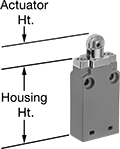
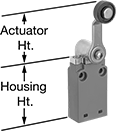
Stack these slim switches together, or fit them into tight spaces. They're rated IP67 for protection from temporary submersion. When an object in motion comes into contact with the actuator, it sends a signal to open or close a circuit. These switches have the rapid-closing action of a snap-acting switch, but have a larger actuator for large objects. They’re often used on conveyor systems and elevators.
Roller-plunger actuators open or close circuits when an object pushes against the roller, which moves the plunger. The roller moves parallel to the mounting direction, so it helps push the plunger even if the force isn’t straight on. The roller also reduces friction during actuation which prevents wear and tear over time.
Roller-lever actuators open or close circuits when material moves across the switch. The roller reduces friction during actuation which prevents wear and tear over time.
Switches with plastic or powder-coated zinc housings are rated NEMA 4 and 13 for protection from washdowns and oil/coolant spraying.
Housing | ||||||||||||||||
|---|---|---|---|---|---|---|---|---|---|---|---|---|---|---|---|---|
| No. of Circuits Controlled | Switch Starting Position | Switch Action | Industry Designation | Switching Current @ Voltage | Max. Voltage | Operating Temp. Range, °F | Actuator Ht. | No. of Wire Leads | Cable Lead Lg., ft. | Lg. | Ht. | Dp. | Housing Material | Each | ||
Roller Plunger Actuator Style | ||||||||||||||||
With Wire Leads | ||||||||||||||||
| D | 2 | 2 Off (Normally Open) and 2 On (Normally Closed) | Springs Back (Momentary) | DPDT | 3 A @ 240 V AC, 0.55 A @ 125 V DC | 250V DC 240V AC | -13° to 158° | 0.6" | 8 | 3 | 1.2" | 2.2" | 0.7" | Plastic | 0000000 | 000000 |
| D | 2 | 2 Off (Normally Open) and 2 On (Normally Closed) | Springs Back (Momentary) | DPDT | 3 A @ 240 V AC, 0.55 A @ 125 V DC | 250V DC 240V AC | -13° to 158° | 0.6" | 8 | 3 | 1.2" | 2.2" | 0.7" | Powder-Coated Zinc | 0000000 | 00000 |
Roller Lever Actuator Style | ||||||||||||||||
With Wire Leads | ||||||||||||||||
| E | 2 | 2 Off (Normally Open) and 2 On (Normally Closed) | Springs Back (Momentary) | DPDT | 3 A @ 240 V AC, 0.55 A @ 125 V DC | 250V DC 240V AC | -13° to 158° | 2.1" | 8 | 3 | 1.2" | 2.2" | 0.7" | Plastic | 0000000 | 00000 |
| E | 2 | 2 Off (Normally Open) and 2 On (Normally Closed) | Springs Back (Momentary) | DPDT | 3 A @ 240 V AC, 0.55 A @ 125 V DC | 250V DC 240V AC | -13° to 158° | 2.1" | 8 | 3 | 1.2" | 2.2" | 0.7" | Powder-Coated Zinc | 0000000 | 00000 |
Washdown Limit Switches
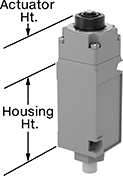
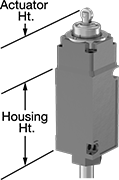
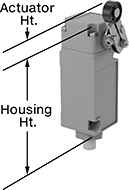
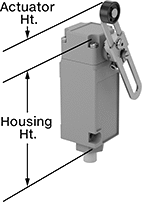
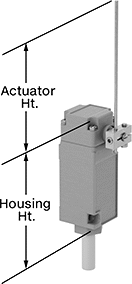
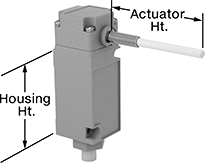
Rated NEMA 3S and IP69K, these switches can handle washdowns with high pressures and temperatures. They’re also protected from oil/coolant spraying, precipitation, and temporary submersion. When an object in motion contacts the actuator, it sends a signal to open or close a circuit. These switches have the rapid-closing action of a snap-acting switch, but with a larger actuator. This makes them a good choice for use with large objects—for instance, a box on a conveyor runs into the switch, stopping the conveyor.
Switches with a plunger actuator require a push to actuate, similar to a button.
Switches with a roller plunger actuator trigger just like a plunger actuator but reduce friction during actuation thanks to their roller. This limits wear and tear on the switch.
Switches with a roller lever actuator combine the larger actuation area of a standard lever with a smooth gliding roller actuator. They minimize friction to limit wear and tear on your switch.
Switches with a rod actuator use a rod extending out of the body to actuate, so they’ll activate even if an object is far away.
Switches with a wobble stick actuator have an arm that rotates 360°, so you don’t need to align it in a specific direction. Since the actuator is flexible, it won’t snap if pushed backward. That makes these switches a great choice for systems that get jammed often.
Styles D, E, and F let you adjust the actuator’s height to align it with your target.
Housing | ||||||||||||||||
|---|---|---|---|---|---|---|---|---|---|---|---|---|---|---|---|---|
| Style | No. of Circuits Controlled | Switch Starting Position | Switch Action | Industry Designation | Switching Current @ Voltage | Max. Voltage | Operating Temp. Range, °F | Actuator Ht. | No. of Wire Leads | Cable Lead Lg., ft. | Lg. | Ht. | Dp. | Housing Material | Each | |
Plunger Actuator Style | ||||||||||||||||
With Wire Leads | ||||||||||||||||
| A | 2 | 2 Off (Normally Open) or 2 On (Normally Closed) | Springs Back (Momentary) | DPDT | 10 A @ 240 V AC, 1 A @ 250 V DC | 240V AC 250V DC | 14° to 221° | 1.5" | 5 | 8 | 1.5" | 3.1" | 1.6" | Zinc | 00000000 | 0000000 |
Roller Plunger Actuator Style | ||||||||||||||||
With Wire Leads | ||||||||||||||||
| B | 2 | 2 Off (Normally Open) or 2 On (Normally Closed) | Springs Back (Momentary) | DPDT | 10 A @ 240 V AC, 1 A @ 250 V DC | 240V AC 250V DC | 14° to 221° | 1.9" | 5 | 8 | 1.5" | 3.1" | 1.6" | Zinc | 00000000 | 000000 |
Roller Lever Actuator Style | ||||||||||||||||
With Wire Leads | ||||||||||||||||
| C | 2 | 2 Off (Normally Open) or 2 On (Normally Closed) | Springs Back (Momentary) | DPDT | 10 A @ 240 V AC, 1 A @ 250 V DC | 240V AC 250V DC | 10° to 200° | 1.5" | 5 | 8 | 1.5" | 4.6" | 1.6" | Zinc | 00000000 | 000000 |
| D | 2 | 2 Off (Normally Open) or 2 On (Normally Closed) | Springs Back (Momentary) | DPDT | 10 A @ 240 V AC, 1 A @ 250 V DC | 240V AC 250V DC | 10° to 200° | 1"-3.75" | 5 | 8 | 1.5" | 4.6" | 1.6" | Zinc | 00000000 | 000000 |
Rod Actuator Style | ||||||||||||||||
With Wire Leads | ||||||||||||||||
| E | 2 | 2 Off (Normally Open) or 2 On (Normally Closed) | Springs Back (Momentary) | DPDT | 10 A @ 240 V AC, 1 A @ 250 V DC | 240V AC 250V DC | 10° to 200° | 0"-5.5" | 5 | 8 | 1.5" | 4.6" | 1.6" | Zinc | 00000000 | 000000 |
Wobble Stick Actuator Style | ||||||||||||||||
With Wire Leads | ||||||||||||||||
| F | 2 | 2 Off (Normally Open) or 2 On (Normally Closed) | Springs Back (Momentary) | DPDT | 10 A @ 240 V AC, 1 A @ 250 V DC | 240V AC 250V DC | 10° to 200° | 0"-5" | 5 | 8 | 1.5" | 4.6" | 1.6" | Zinc | 00000000 | 000000 |
Snap-Acting Switches
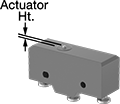
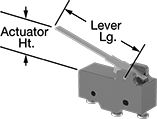
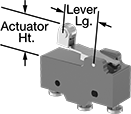
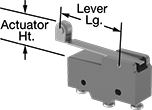
Open and close circuits in a snap. These switches actuate quickly to minimize arcing and prevent contacts from sticking. They’re often used to indicate that an appliance or enclosure door is open. You can also use them inside limit, pressure, and temperature switches.
Switches with a plunger actuator require a push to actuate, similar to a button.
Switches with a lever actuator have an arm that extends to give them a larger actuation area than switches with a plunger actuator.
Switches with a roller lever actuator combine the larger actuation area of a standard lever with a smooth gliding roller actuator. They minimize friction to limit wear and tear on your switch.
Plastic covers (sold separately) are compatible with switches with screw terminals. They fit over the bottom of the switch to prevent contact with live terminals.
Switches | ||||||||||||||||||
|---|---|---|---|---|---|---|---|---|---|---|---|---|---|---|---|---|---|---|
Housing | Plastic Covers | |||||||||||||||||
| No. of Circuits Controlled | Switch Starting Position | Switch Action | Industry Designation | Switching Current @ Voltage | Max. Voltage | Horsepower @ Switching Voltage | Operating Temp. Range, °F | Actuator Ht. | No. of Terminals | Lg. | Ht. | Dp. | Lever Lg. | Each | Each | |||
Plunger Actuator Style | ||||||||||||||||||
With Screw Terminals | ||||||||||||||||||
| A | 2 | 2 Off (Normally Open) or 2 On (Normally Closed) | Springs Back (Momentary) | DPDT | 10 A @ 250 V AC, 10 A @ 8 V DC | 480V AC 250V DC | 1/4 hp @ 250 V AC | -13° to 176° | 0.08" | 6 | 1.94" | 0.89" | 0.69" | __ | 000000 | 000000 | 0000000 | 00000 |
With Tab Terminals | ||||||||||||||||||
| A | 2 | 2 Off (Normally Open) or 2 On (Normally Closed) | Springs Back (Momentary) | DPDT | 10 A @ 250 V AC, 10 A @ 8 V DC | 480V AC 250V DC | __ | -13° to 176° | 0.08" | 6 | 1.94" | 0.89" | 0.69" | __ | 00000000 | 00000 | 000000 | 00 |
Lever Actuator Style | ||||||||||||||||||
With Screw Terminals | ||||||||||||||||||
| F | 2 | 2 Off (Normally Open) or 2 On (Normally Closed) | Springs Back (Momentary) | DPDT | 10 A @ 250 V AC, 10 A @ 8 V DC | 480V AC 250V DC | 1/4 hp @ 250 V AC | -13° to 176° | 0.29" | 6 | 1.94" | 0.95" | 0.69" | 2.5" | 000000 | 00000 | 0000000 | 0000 |
| F | 2 | 2 Off (Normally Open) or 2 On (Normally Closed) | Springs Back (Momentary) | DPDT | 10 A @ 250 V AC, 10 A @ 8 V DC | 480V AC 250V DC | 1/4 hp @ 250 V AC | -13° to 176° | 0.4" | 6 | 1.94" | 0.89" | 0.69" | 2.5" | 00000000 | 00000 | 0000000 | 0000 |
With Tab Terminals | ||||||||||||||||||
| F | 2 | 2 Off (Normally Open) or 2 On (Normally Closed) | Springs Back (Momentary) | DPDT | 10 A @ 250 V AC, 10 A @ 8 V DC | 480V AC 250V DC | __ | -13° to 176° | 0.4" | 6 | 1.94" | 0.89" | 0.69" | 2.5" | 00000000 | 00000 | 000000 | 00 |
Roller Lever Actuator Style | ||||||||||||||||||
With Screw Terminals | ||||||||||||||||||
| G | 2 | 2 Off (Normally Open) or 2 On (Normally Closed) | Springs Back (Momentary) | DPDT | 10 A @ 250 V AC, 10 A @ 8 V DC | 480V AC 250V DC | 1/4 hp @ 250 V AC | -13° to 176° | 0.58" | 6 | 1.94" | 0.95" | 0.69" | 1.2" | 000000 | 00000 | 0000000 | 0000 |
| H | 2 | 2 Off (Normally Open) or 2 On (Normally Closed) | Springs Back (Momentary) | DPDT | 10 A @ 250 V AC, 10 A @ 8 V DC | 480V AC 250V DC | 1/4 hp @ 250 V AC | -13° to 176° | 0.68" | 6 | 1.94" | 0.95" | 0.69" | 1.9" | 000000 | 00000 | 0000000 | 0000 |
| H | 2 | 2 Off (Normally Open) or 2 On (Normally Closed) | Springs Back (Momentary) | DPDT | 10 A @ 250 V AC, 10 A @ 8 V DC | 480V AC 250V DC | 1/4 hp @ 250 V AC | -13° to 176° | 0.74" | 6 | 1.94" | 0.89" | 0.69" | 1.9" | 00000000 | 00000 | 0000000 | 0000 |
With Tab Terminals | ||||||||||||||||||
| H | 2 | 2 Off (Normally Open) or 2 On (Normally Closed) | Springs Back (Momentary) | DPDT | 10 A @ 250 V AC, 10 A @ 8 V DC | 480V AC 250V DC | __ | -13° to 176° | 0.74" | 6 | 1.94" | 0.89" | 0.69" | 1.9" | 00000000 | 00000 | 000000 | 00 |

























